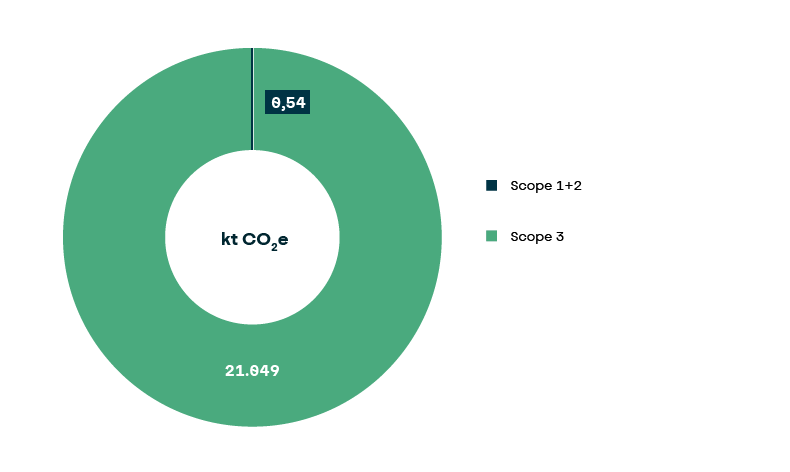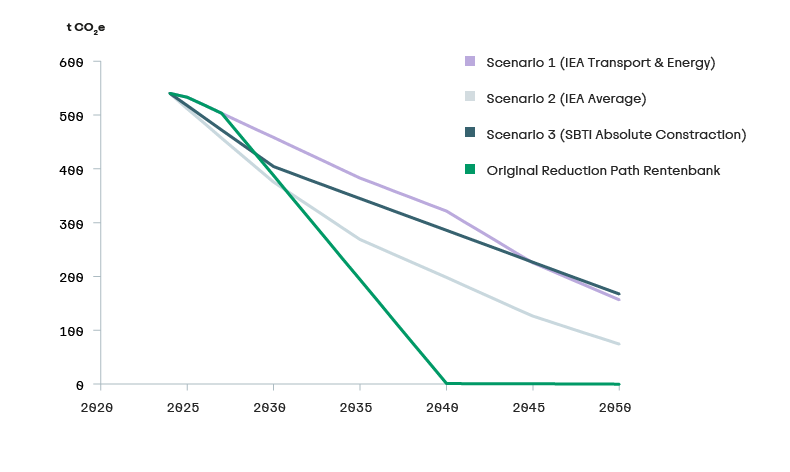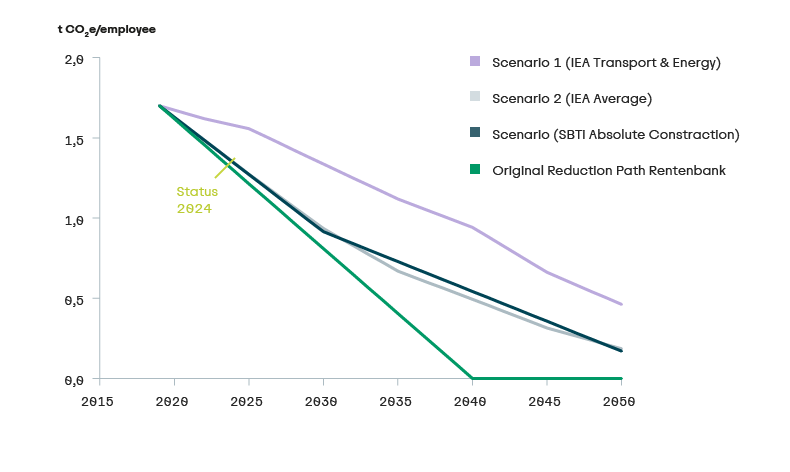Emissions in our internal operations and value chain
Total emissions of Landwirtschaftliche Rentenbank in 2024 in kt CO2e1

Figure 6: Rentenbank’s total emissions in 2024
Because 99.997% of Rentenbank’s total emissions are classified as financed emissions (Scope-3-Cat. 15), these represent the focus of the bank’s climate strategy.
Current GHG footprint
The conversion factors of the Version 1.0 VfU Standard after the 2022 update form the basis for calculating CO2e emissions for our GHG footprint in 2024.
Because our own building on Hochstraße is currently being renovated while fulfilling the preservation requirements for a protected historical monument, we are using the “Goldenes Haus” building at Theodor-Heuss-Allee 80, where we have leased four floors, as an interim headquarters.
The GHG emissions caused in our internal operations in the years 2022 to 2024 are shown in the table below.
Key ecological indicators
|
Greenhouse gas emissions |
2024 | 20231 | 20221 | ||
| Bank building | 520.9 | 487.7 | 428.3 | ||
| Motor vehicle fleet | 19.2 | 15.7 | 12.2 | ||
| Scope-1- und Scope-2-emissions | 540.1 | 503.4 | 440.5 | ||
| Scope-1- und Scope-2-emissions per employee | 1.3 |
1.3 |
1.2 |
||
| Full-time equivalent employees | 421 | 388 | 359 | ||
| Table 3: Greenhouse gas footprint of internal operations and value chain | |||||
The increased emissions in the bank’s internal operations are mainly attributable to the higher need for heating energy resulting from the sharply higher staff numbers. Emissions from the motor vehicle fleet have also risen in the last two years due to the increase in on-site inspections and tours related to German federal government programmes and the increase in business travel after the coronavirus crisis.
Targets, emissions reduction pathway, and actions in the bank’s internal operations
As a credit institution operating with a small number of employees at a single site in Frankfurt am Main, Rentenbank’s environmental impacts are relatively modest. Nevertheless, Rentenbank is committed to continuously reducing its environmental footprint. The reduction targets presented in the chapter below are based on consumption levels from the year 2019 given that we will move back into our renovated building on Hochstraße in 2030. Our emission reduction targets in our internal operations refer to two primary emission sources: the building and the motor vehicle fleet. Despite the fact that emissions are currently rising in both areas, Rentenbank is sticking with its reduction targets for 2030 and 2040.
| Reduction targets | Absolute emissions 2019 (in t CO2e) |
Actual emissions 2024 (in t CO2e) |
Taget 2030 (as % from base year 2019) |
Traget 2030 (in t CO2e) |
Degree of attainment (in %) | Reference scenario |
| Bank building | 449.6 | 540.1 | > -75 | 105.3 | +20 | Own reduction pathway |
| Motor vehicle fleet | 16.0 | 19.2 | > -70 | 4.8 | +20 | Own reduction pathway |
| Table 4: Reduction targets in the bank’s internal operations (absolute) | ||||||
| Reduction targets | Absolute emissions 20192 (in t CO2e) |
Target 2040 (in % from the base year 2019) |
Reference scenario |
| Bank building | 449.7 | > -95 %
Net Neutrality |
Own reduction pathway |
| Motor vehicle fleet | 16.0 | > -95 %
Net Neutrality |
Own reduction pathway |
| Table 5: Reduction targets for emissions in the bank’s internal operations (relative) | |||
Rentenbank’s reduction target for its internal operations is well above the level of decarbonisation that would be required to achieve a 1,5-degree scenario. Thus, it is considerably lower than the conventional reduction pathways based on a 1,5-degree scenario (see Figure 7). These pathways reflect the required rate by which the GHG emissions intensity would have to be reduced in order to align business activities with a 1,5-degree target.
Because the reduction possibilities in the leased property on Theodor-Heuss-Allee are limited, only a modest level of decarbonisation is expected until Rentenbank moves back into the building on Hochstraße, tentatively in 2028.
Rentenbank’s reduction pathway compared to reference values

Figure 7: Rentenbank’s reduction pathway compared to reference values
Although emissions increased in absolute terms, emissions per employee remain within the targeted reduction pathway due to the nearly 50% increase in Rentenbank’s staff between 2019 and 2024.
Rentenbank’s GHG emissions reduction pathway per employee compared to reference values

Figure 8: Rentenbank’s GHG emissions reduction pathway per employee compared to reference values
In its internal operations, Rentenbank plans to reduce its electricity consumption, electrify its motor vehicle fleet, and lower its use of resources. A selective list of the sub-targets and actions planned for the coming years in the bank’s internal operations is presented below:
| Sub-targets for internal operations | Target year |
| Development of an energy management system | 2026 |
| Limitation of directly purchased electricity consumption to <850,000 kWh (2022: 801,400) by means of smart lighting control systems, installation of a time control system for the kitchen ventilation system, reduction of computer server consumption, actions to raise employees’ awareness | 2025 |
| Expansion of fully or partially electric pool vehicles and technician vehicles to 40% | 2027 |
| Table 6: Sub-targets for internal operations | |
However, the planned return to our building on Hochstraße, which is currently being renovated in observance of historical monument preservation regulations, in 2027 will have the greatest impact on our emissions. This building will be connected to the district heating network of the City of Frankfurt.
The utility Mainova has stated its intention of making the district heating system climate-neutral by the year 2040. Our goal for 2040 is to achieve climate neutrality in our internal operations.
Compensation measures will only be employed in exceptional cases and only in the form of legally recognised emission reduction actions according to the Clean Development Mechanism of the United Nations, the Gold Standard, or a comparable standard. Our efforts in this direction are guided by the fundamental principle: avoidance, reduction and – only when unavoidable – compensation.